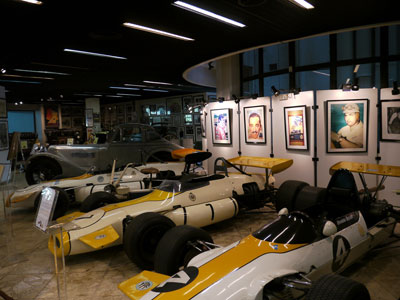Hidden car museum in Buenos Aires
Strolling along Avenida del Libertador in Buenos Aires on an April-May ’10 trip to Argentina, I passed a building identified as the Automóvil Club Argentino (1850 Avenida del Libertador, Buenos Aires; phone 0800 777 2894), easily identified by the yellow flags out front and the steady stream of locals coming and going to renew their driving permits and tend to other bureaucratic business.
On a whim, I doubled back and entered the lobby. A pair of vintage Fords flanked the sunlit marble room, including a stunning 1908 touring model and an open-top race car from the 1920s. The body shell of a vintage Ferrari sat next to the 1908 Ford, its sculpted flanks painted a bright blue. Even without a motor or tires, it still looked like it would run laps around the average family sedan.
I asked a guard if there were other cars that I might be able to see. She directed me to the fourth floor but offered no details. Taking the elevator with several office workers, I quickly surmised that tourists were not the usual audience this building hosted. Exiting the elevator, I crossed the hall and opened a small, nondescript door to reveal an automotive surprise.
Resembling a collector’s garage, the room was packed full of vintage vehicles. There was an impressive display of die-cast models (from small, 1:64 Matchbox® size to large, 1:18 scale) by the window, and a wealth of historic photos, commemorative certificates and other auto ephemera covered the walls. For an auto aficionado, it was an overwhelming sight.
What most distinguishes the Automóvil Club collection is its focus on cars from the turn of the 20th century — many from long-forgotten makers — and others from established automakers like Renault, Peugeot and Cadillac, which have sold cars to Argentineans for upward of 80 years.
An 1898 Holzman and a 1904 Cadillac, both from America, share floor space with a Mors (an obscure French automaker) from 1899, a Darracq (another French brand) and, from England, a 1908 Swift. For fans of German luxury cars, there are an 1892 Daimler and an 1897 Benz. The collection also features several work trucks, motorcycles and even the odd vintage scooter.
In addition, visitors can learn about the 1927-1928 Yruam, a hand-built prototype by a local aeronautical engineer, which incorporates much of the technology found in modern automobiles, including four-wheel mechanical braking, a multiliter engine and the use of aluminum.
A tribute to local auto racing legend Juan Fangio is prominently featured, along with three restored race cars: a 1971 Brabham BT 36, a BWA and a 1970 Brabham BT 30.
If the museum doesn’t slake your thirst for all things auto, head upstairs to the club’s library. Thousands of trade and consumer magazines, books and other items are free to peruse, but, with no computerized database, guests might want to ask the librarian for assistance. The librarian on duty during my visit didn’t speak English, but I managed, with my very limited Spanish, to communicate.
Open 10-5 Monday-Friday, the Automóvil Club Argentino offers a unique lens through which to view the country’s rapid industrial and cultural development. Admission is free.
JEREMY WILLINGER
New York, NY

